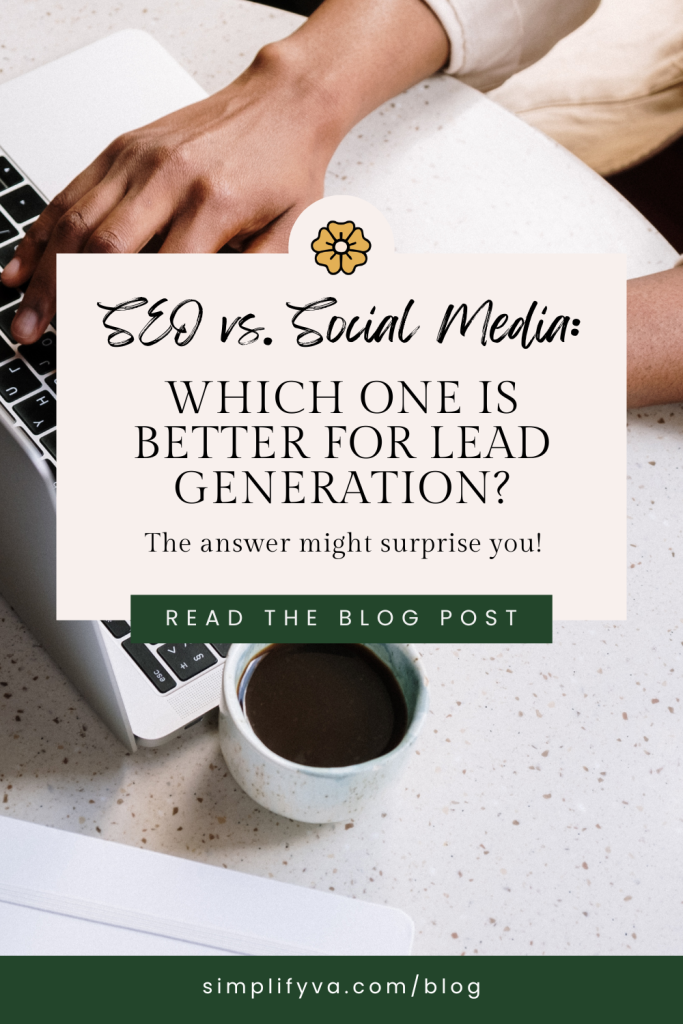SEO vs. Social Media: Where Should You Invest Your Marketing Efforts for Sustainable Growth?

If you’re unsure whether to invest more in SEO or social media, you’re not alone. Both play a role in digital marketing, but the real question is: which one delivers sustainable results without draining your time and energy?
Many business owners feel pressured to be active daily on social media to maintain engagement. Others turn to SEO, hoping to rank on Google and attract organic traffic over time. The reality? Both strategies have their place, but their long-term impact and effort requirements differ significantly.
This guide will break down the core differences, benefits, and challenges of SEO vs. social media—and how you can create a balanced marketing strategy that supports sustainable business growth without the burnout.
SEO vs. Social Media: Understanding the Core Difference
At their foundation, SEO and social media serve different purposes in visibility and lead generation:
- SEO (Search Engine Optimization) focuses on long-term, organic search visibility by optimizing your website and blog content for Google and other search engines. Once published, well-optimized content continues attracting traffic without ongoing effort.
- Social Media Marketing is centered on real-time engagement on platforms like Instagram, LinkedIn, TikTok, and Facebook. It requires consistent posting to stay visible, but content has a short lifespan.
Longevity vs. Immediate Reach
The biggest difference between these two strategies is content longevity:
- SEO is evergreen: A well-optimized blog post can bring traffic to your website for months or even years.
- Social media is short-lived: Posts typically generate engagement for a few hours to a few days before getting buried in the feed.
If sustainability and time freedom are priorities, SEO is a non-negotiable investment.
Why SEO Wins for Sustainable Growth
For business owners who want long-term visibility without constantly being online, SEO is the smarter investment.
Key Benefits of SEO:
✔ Drives Organic Traffic 24/7 – Unlike social media, SEO works for you even when you’re not actively promoting content.
✔ Builds Trust & Authority – Google favors consistent, high-quality content, helping you rank higher and stay visible.
✔ Compounds Over Time – A single blog post can attract visitors for years, while a social media post disappears within days.
Real-World Example: How SEO Works for You
Let’s say you publish a blog post titled “How to Choose the Right Website Designer.”
- With the right keywords, your article ranks on Google.
- Someone searching for a website designer finds your blog, reads your insights, and visits your site.
- That visitor books a discovery call or downloads a free guide, turning into a warm lead—without any daily content creation from you.
This is the power of SEO: It allows ideal clients to find you organically, even when you’re not actively marketing.
The Case for Social Media: Quick Wins, But High Maintenance
Social media has its advantages, especially for brand awareness and engagement, but it requires constant content creation.
Key Benefits of Social Media:
✔ Great for Engagement & Community Building – Social platforms allow for direct interactions with your audience.
✔ Boosts Brand Awareness – Regular posting keeps your business visible in a fast-paced digital world.
✔ Showcases Personality & Behind-the-Scenes Content – Unlike structured SEO content, social media allows for more personal storytelling.
Real-World Example: How Social Media Works
You post a high-value Instagram Reel with business tips.
- It gets strong engagement for 24 hours, with likes and comments.
- After a few days, the reach drops significantly.
- To stay visible, you need to create new content regularly.
While social media builds connections, it’s not a sustainable long-term strategy unless paired with content that has lasting value—like SEO.
Where Should You Focus? (The Balanced Approach)
If you want consistent leads and sustainable business growth, SEO should be your primary marketing focus—but social media can still play a supporting role.
Here’s a simple, time-saving strategy to balance both:
1. Start with SEO-First Content
- Publish at least 2 SEO-optimized blog posts per month to build a content library that attracts leads consistently.
2. Repurpose Blog Content for Social Media
- Instead of creating content from scratch, break down blog posts into social media snippets (quotes, carousels, LinkedIn posts).
3. Use Social Media to Drive Traffic to Your Website
- Every post should include a Call-to-Action (CTA) that directs followers to your blog, email list, or services—so you’re not just relying on likes and comments.
The Best Marketing Strategy: Let Your Website Work for You
Marketing should support your business, not overwhelm you. By focusing on SEO as the foundation and using social media strategically, you can build a marketing system that attracts leads without draining your energy.
Key Takeaways:
✔ SEO provides long-term traffic and authority with minimal ongoing effort.
✔ Social media offers short-term engagement, but requires constant content creation.
✔ The best strategy? Prioritize SEO-first content and repurpose it for social media to maximize impact.
✔ Your website should be your marketing hub, with social media acting as a supporting tool—not the main strategy.
If you’re ready to stop relying on social media for leads and start building sustainable visibility with SEO and content marketing, I can help.
Check out my Done-for-You Blog Management services and start attracting consistent leads—without the burnout.
